
James McNeill Whistler Harmony in Blue and Silver: Trouville 1865

Largely hastily and secretly written by lobbyists, and mostly unread by lawmakers. Doesn’t seem to be the way to do things. Have you no pride?
• Senate Approves Republicans’ Tax Overhaul (R.)
The U.S. Senate approved a sweeping tax overhaul on Saturday, moving Republicans and President Donald Trump a major step closer to their goal of slashing taxes for businesses and the rich while offering everyday Americans a mixed bag of changes. In what would be the largest U.S. tax overhaul since the 1980s, Republicans want to add $1.4 trillion over 10 years to the $20 trillion national debt to finance changes that they say would further boost an already growing economy. U.S. stock markets have rallied for months in hopes Washington would provide significant tax cuts for corporations. Following the 51-49 vote, talks will begin, likely next week, between the Senate and the House of Representatives, which has already approved its own tax bill. The two chambers must craft a single bill to send to Trump to sign into law.
Trump wants that to happen before the end of the year, allowing him and his Republicans to score their first major legislative achievement of 2017, despite controlling the White House, the Senate and the House since he took office in January. Celebrating their victory, Republican leaders said the tax cuts would encourage U.S. companies to invest more and boost economic growth. “We have an opportunity now to make America more competitive, to keep jobs from being shipped offshore and to provide substantial relief to the middle class,” said Mitch McConnell, the Republican leader in the Senate. The tax overhaul is seen by Republicans as crucial to their prospects in the November 2018 mid-term election campaigns when they will have to defend their majorities in Congress.
In a legislative battle that moved so fast a final draft of the bill was unavailable to the public until just hours before the vote, Democrats slammed the measure as a give-away to businesses and the rich financed with billions in taxpayer debt.

Stockman agrees.
• Debt, Taxes, Growth And The GOP Con Job (Stockman)
During more than four decades in Washington and on Wall Street it is quite possible that we never picked up any useful skills. But along the way we did unavoidably acquire what amounts to a survival tool in those fair precincts—-namely, a nose for the con job. And what a doozy we have going now as a desperate mob of Capitol Hill Republicans attempts to enact something—anything— that can be vaguely labeled tax reform/tax cut. And for a reason that lies only slightly below the surface. In a word, they are scared to death that the political train wreck in the Oval Office will put them out of business for years to come. So they are attempting to erect a shield of legislative accomplishment that can be sold in 2018 as the work of the GOP Congress, not the unhinged tweet-storm in the White House.
To be sure, some element of political calculus always lies behind legislation. For instance, the Dems didn’t pass the Wagner Act in 1935, the Voting Rights Act of 1965 or the Affordable Care Act of 2010 as an exercise in pure civic virtue—-these measures targeted huge constituencies with tens of millions of votes at stake. Still, threadbare theories and untoward effects are just that; they can’t be redeemed by the risible claim that this legislative Rube Goldberg Contraption is being jammed through sight unseen (in ACA redux fashion) for the benefit of the rank and file Republican voters—and most especially not for the dispossessed independents and Dems of Flyover America who voted for Trump out of protest against the failing status quo. To the contrary. The GOP tax bill is of the lobbies, by the PACs and for the money. Period.
There is no higher purpose or even nugget of conservative economic principle to it. The battle cry of “pro-growth tax cuts” is just a warmed over 35 year-old mantra from the Reagan era that does not remotely reflect the actual content of the bill or disguise what it really is: Namely, a cowardly infliction of more than $2 trillion of debt on future American taxpayers in order to fund tax relief today for the GOP’s K-Street and Wall Street paymasters. On a net basis, in fact, fully 97% of the $1.412 trillion revenue loss in the Senate Committee bill over the next decade is attributable to the $1.369 trillion cost of cutting the corporate rate from 35% to 20% (and repeal of the related AMT). All the rest of the massive bill is just a monumental zero-sum pot stirring operation.

She sings.
• SocGen: The Good Times Are Coming To An End In 2018 (BI)

The party’s almost over, Societe Generale strategists say. A strong earnings recovery and a growing economy have fueled investor interest in buying risky corporate bonds this year. SocGen’s credit strategists see 2018 as a transition year for the credit market, with the low-yield environment that has driven some investors into riskier credit instruments likely to turn. “We expect 2018 to see the last of the good times, with very positive conditions early in the year,” the strategists Juan Esteban Valencia and Guy Stear said. “In our view, the ultra-low yield environment will remain in place, making credit a very attractive proposition, even at current levels. Additionally, economic growth should remain healthy and the CSPP (and QE program) should remain supportive of the asset class. However, at some point, we expect these idyllic conditions to start shifting.”
By stopping their bond-buying programs, the ECB and the Fed would leave credit, including the market for government bonds, more vulnerable to market movements, according to SocGen. Global credit already looks overvalued, the strategists said. Sustained demand for riskier corporate bonds has reduced the spread between their yields and comparable government bonds to the lowest levels in three years. A previous study they conducted showed that the level of spreads explained about half of the following year’s performance. “Low spreads are the mother of negative excess returns,” they said, adding that credit markets would start 2018 on the wrong footing with tight valuations and low breakevens. Like Societe Generale’s credit strategists, the firm’s economists see a risk that the US economy starts to slow down in 2019 or 2020 amid lower profit margins.
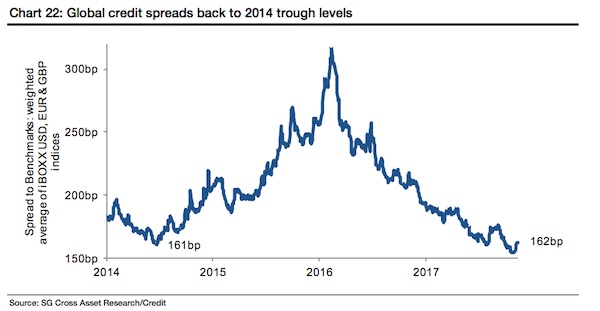

More great graphs from Lance. The last breaths of the system: It now requires nearly $4.00 of debt for each $1.00 of economic growth..
• Keeping You Awake At Night (Roberts)
[..] while Janet Yellen was focused on Federal Debt, the real issue is total debt as a percentage of the economy. Every piece of leverage whether it is government debt, personal debt and even leverage requires servicing which detracts “savings” from being applied to more productive uses. Yes, in the short-term debt can be used to supplant consumption required to artificially stimulate growth, but the long-term effect is entirely negative. As shown in the chart below, total system debt how exceeds 370% of GDP and is rising.
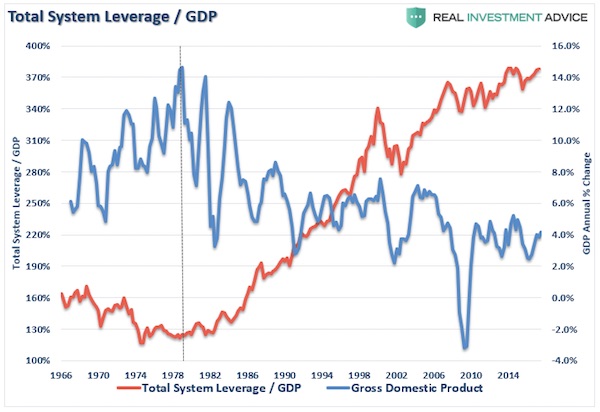
It now requires ever increasing levels of debt to create each $1 of economic growth. From 1959 to 1983, it required roughly $1.25 of debt to create $1 of economic activity. However, as I have discussed previously, the deregulation of the financial sector, combined with falling interest rates, led to a debt explosion. That debt explosion, which allowed for an excessive standard of living, has led to the long-term deterioration in economic growth rates. It now requires nearly $4.00 of debt for each $1.00 of economic growth.
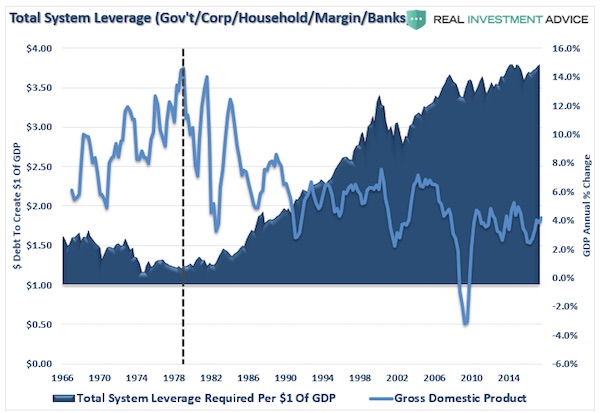

Tick. Tock.
• Stock Market Acceleration In Final Stage (Kessler)
Secular stock-market bullish trends tend to accelerate as they mature. The last three big bull moves in the Dow Jones Industrial Average look very similar and suggest a near-term major correction. See below:
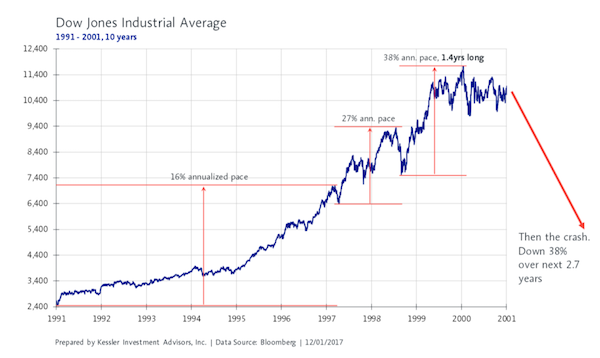
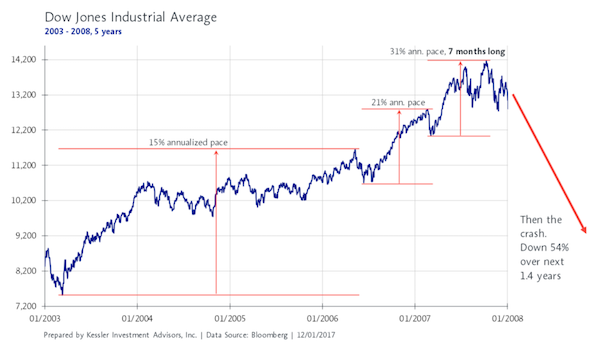
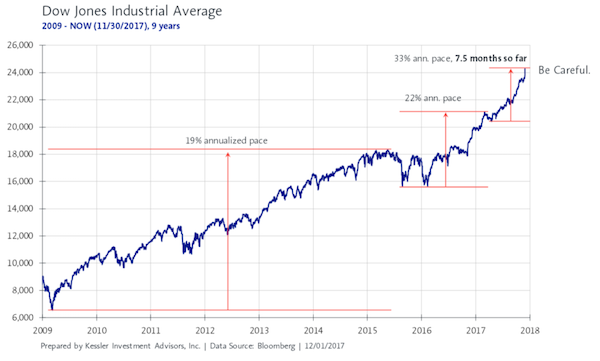

What happens when you blow bubbles to hide your failures. But just make homes places to live in again, not speculative assets. It’s not that hard to understand, or do.
• Pensions Aren’t The Ticking Timebomb – Rents Are (G.)
Scottish Widows is the sort of unassuming pensions company that rarely likes to publicly criticise government policy. But an analysis it published this week is a stark warning about the ticking time bomb that will explode in 10 to 20 years’ time. And it’s not pension incomes that are the worry – it’s the fact that so many of tomorrow’s pensioners who never got on to the property ladder in the 2000s and 2010s will have to find huge amounts of money to pay ever-escalating rents to private landlords. Scottish Widows skirts around the issue by suggesting that non-homeowners currently in their 50s should start saving an extra £6,000 a year now to be able to afford their rent in retirement. As if people on low incomes are going to find that sort of money. The reason they are renting is that they were never able to find the savings for a deposit on a house in the first place, or didn’t earn enough to qualify for a mortgage.
The reality is that these people are likely to retire with little more than the state pension plus a small bit of private pension. Maybe they will be picking up about £200 a week once they are 67. Given that the average rent in England and Wales is £845 a month – and in London it’s about £1,250 a month – then the whole lot will be gobbled up by the landlord. So the taxpayer will have no alternative but to step in and pay most of the rent, and we are then on the hook for payments going on for maybe 20 or 30 years. All so that the buy-to-let landlord with multiple properties can enjoy a lavish retirement themselves. This is the lunacy of promoting buy to let as a long term form of tenure for millions of people. Even in developed countries where renting is common, such as Germany, most people are living in a home they own by the time they reach retirement.
Renting all the way through retirement, funded by the taxpayer, to a landlord who has the power to evict without reason and at short notice, is the worst possible situation. And it’s one we are hurtling towards. Make no mistake about the dramatic change in the retirement landscape that is coming. Scottish Widows projects that one in eight retirees will be renting by 2032 – treble today’s figure. After that it will continue rising. It says there is a £43bn gap between the income and savings people have now and what the rent bill will be in retirement. That’s more than one-third of the entire NHS budget for a year – to be squandered on rent.

“In February 2017, Tesla hyped these Model 3 production numbers for 2017: “Our Model 3 program is on track to start limited vehicle production in July and to steadily ramp production to exceed 5,000 vehicles per week at some point in the fourth quarter and 10,000 vehicles per week at some point in 2018.” November is solidly in the fourth quarter. 5,000 vehicles per week would mean over 20,000 a month. OK, this is November and not December, so maybe 4,000 a week for a total of 16,000. We got 345.”
Today was the monthly moment of truth for automakers in the US. They reported the number of new vehicles that their dealers delivered to their customers and that the automakers delivered directly to large fleet customers. These are unit sales, not dollar sales, and they’re religiously followed by the industry. Total sales in November rose 0.9% from a year ago to 1,393,010 new vehicles, according to Autodata, which tracks these sales as they’re reported by the automakers. Sales of cars dropped 8.2%. Sales of trucks – which include SUVs, crossovers, pickups, and vans – rose 6.6%. Strong replacement demand from the hurricane-affected areas in Texas papered over weaknesses elsewhere. As always, there were winners and losers. And one of the losers was Tesla.
First things first: There is nothing wrong with a tiny automaker trying to design, make, and sell cool but expensive cars that a few thousand Americans might buy every month, and trying to do so on a battleground dominated by giants. Porsche has been doing that for years. Porsche AG is owned by Volkswagen AG, which is itself majority-owned by Porsche Automobil Holding SE. Tesla is out there by itself. And Tesla has put electric vehicles on the map. That was a huge feat. EVs have been around since the 1800s, but given the challenges that batteries posed, they simply didn’t catch on until Tesla made EVs cool. Yet Tesla has to buy the battery cells from battery makers, such as Panasonic. Tesla isn’t quite out there by itself, though. The Wall Street hype machine backs it up, dousing it with billions of dollars on a regular basis to burn through as fast as it can.
This masterful hype has created a giant market capitalization of about $52 billion, more than most automakers, including Ford ($50 billion). It’s not far behind GM ($61 billion). But Tesla – which lost $619 million in Q3 – delivered only 3,590 vehicles in November in the US, down 18% from a year ago. There are all kinds of interesting aspects about this. One: 3,590 vehicles amounts to a market share of only 0.26%, of the 1,393,010 new cars and trucks sold in the US in November. Porsche outsold Tesla by 55% (5,555 new vehicles). Two: Tesla doesn’t report monthly deliveries. It wants to play with the big boys, but it doesn’t want people to know on a monthly basis just how crummy and by comparison inconsequential its US sales numbers are. Opaque and dedicated to hype, it refuses to disclose how many vehicles it delivered that month in the US.
So the industry is estimating Tesla’s monthly US sales. Tesla discloses unit sales data in its quarterly earnings reports, long after everyone has already forgotten about the months in which they occurred. Three: So how are Model 3 sales doing? Since Tesla doesn’t disclose its monthly deliveries in the US, the industry is guessing. The assembly line still isn’t working. “Manufacturing bottlenecks,” as Tesla calls it, and “manufacturing hell,” as Elon Musk calls it, rule the day. In Q3, Tesla delivered 220 handmade Model 3’s. In October, it delivered about 145 handmade units. In November, the assembly line still wasn’t assembling cars. Inside EVs estimates that Tesla delivered a whopping 345 units in November.

Interesting angle.
• AI Has Already Taken Over, It’s Called the Corporation (Lent)
When corporations were first formed back in the seventeenth century, their inventors—just like modern software engineers—acted with what they believed were good intentions. The first corporate charters were simply designed to limit an investor’s liability to the amount of their investment, thus encouraging them to finance risky expeditions to India and Southeast Asia. However, an unintended consequence soon emerged, known as moral hazard: with the potential upside greater than the downside, reckless behavior ensued, leading to a series of spectacular frauds and a market crash that resulted in corporations being temporarily banned in England in 1720. Thomas Jefferson and other leaders of the United States, aware of the English experience, were deeply suspicious of corporations, giving them limited charters with tightly constrained powers.
However, during the turmoil of the Civil War, industrialists took advantage of the disarray, leveraging widespread political corruption to expand their influence. Shortly before his death, Abraham Lincoln lamented what he saw happening with a resounding prophecy: “Corporations have been enthroned … An era of corruption in high places will follow… until wealth is aggregated in a few hands … and the Republic is destroyed.” Corporations, just like a potential runaway AI, have no intrinsic interest in human welfare. They are legal constructions: abstract entities designed with the ultimate goal of maximizing financial returns for their investors above all else. If corporations were in fact real persons, they would be sociopaths, completely lacking the ability for empathy that is a crucial element of normal human behavior.
Unlike humans, however, corporations are theoretically immortal, cannot be put in prison, and the larger multinationals are not constrained by the laws of any individual country. With the incalculable advantage of their superhuman powers, corporations have literally taken over the world. They have grown so massive that an astonishing sixty-nine of the largest hundred economies in the world are not nation states but corporate entities.

The UN fails to speak out on far too many issues. It has made itself a lame duck.
• The UN Is Investigating Extreme Poverty … In America (G.)
The United Nations monitor on extreme poverty and human rights has embarked on a coast-to-coast tour of the US to hold the world’s richest nation – and its president – to account for the hardships endured by America’s most vulnerable citizens. The tour, which kicked off on Friday morning, will make stops in four states as well as Washington DC and the US territory of Puerto Rico. It will focus on several of the social and economic barriers that render the American dream merely a pipe dream to millions – from homelessness in California to racial discrimination in the Deep South, cumulative neglect in Puerto Rico and the decline of industrial jobs in West Virginia. With 41 million Americans officially in poverty according to the US Census Bureau (other estimates put that figure much higher), one aim of the UN mission will be to demonstrate that no country, however wealthy, is immune from human suffering induced by growing inequality.
Nor is any nation, however powerful, beyond the reach of human rights law – a message that the US government and Donald Trump might find hard to stomach given their tendency to regard internal affairs as sacrosanct. The UN special rapporteur on extreme poverty and human rights, Philip Alston, is a feisty Australian and New York University law professor who has a fearsome track record of holding power to account. He tore a strip off the Saudi Arabian regime for its treatment of women months before the kingdom legalized their right to drive, denounced the Brazilian government for attacking the poor through austerity, and even excoriated the UN itself for importing cholera to Haiti. The US is no stranger to Alston’s withering tongue, having come under heavy criticism from him for its program of drone strikes on terrorist targets abroad.
In his previous role as UN special rapporteur on extrajudicial executions, Alston blamed the Obama administration and the CIA for killing many innocent civilians in attacks he said were of dubious international legality. Now Alston has set off on his sixth, and arguably most sensitive, visit as UN monitor on extreme poverty since he took up the position in June 2014. At the heart of his fact-finding tour will be a question that is causing increasing anxiety at a troubled time: is it possible, in one of the world’s leading democracies, to enjoy fundamental human rights such as political participation or voting rights if you are unable to meet basic living standards, let alone engage, as Thomas Jefferson put it, in the pursuit of happiness?

Untreated traumas. A largely forgotten part of the refugee crisis.
• Despite Greek Shelter, Yazidis Struggle To Integrate (AFP)
Having run the gauntlet of invasion, combat, killings and enslavement by Islamic State jihadists in Iraq, the members of this religious minority have found temporary shelter in the largely agricultural region of Serres in northern Greece. The camp they have been allocated to is one of the best in the country – their prefabricated homes have air conditioning and solar panels to heat water. The grounds are clean and there is a playground for the children. Many hope to be reunited with other Yazidis stranded in Greece, but with the country struggling to manage more than 50,000 refugees and migrants stranded on its territory, that is not always an option. “Creating a camp just for Yazidis is neither possible nor viable,” said a Greek official with knowledge of refugee management efforts.
The camp can normally accommodate 700 people. At the moment there are some 350 Yazidis, most of them women and children, waiting for EU-sponsored relocation to other parts of Europe. Greece’s policy is to move eligible refugees from overcrowded island camps – where they undergo identity checks upon arrival from Turkey – to the mainland, where more comfortable accommodation is available in better camps, UN-funded flats and hotels. But the Yazidis, who have already faced an ordeal keeping their dwindling community together thus far, oppose this policy. This is partly down to fear of other communities. They had a scare earlier this year, when a Yazidi celebration in Kilkis, another part of northern Greece, descended into violence between Arabs and Kurds.
[..] In areas controlled by Islamic State, thousands of women and girls from the Yazidi minority were used as sex slaves and suffered horrific abuse, including rape, abduction, slavery and cruel, inhumane and degrading treatment. The suffering the Yazidis have endured explains why community elders in Serres have written to the migration ministry to officially request that the camp be assigned to Yazidis alone. “We ask for our community not to be disturbed and to live here in safety until we depart,” says Hajdar Hamat, a self-styled spokesman for the Yazidis at the camp. “Everybody knows about our peoples’ genocide. We did not come from Sinjar to Greece for fun. Europe must protect us,” says Hamat.








